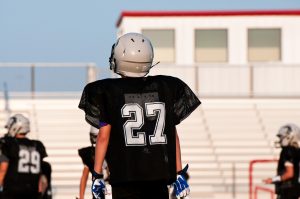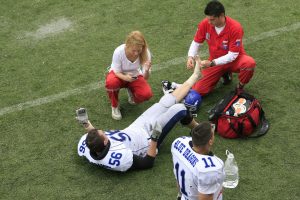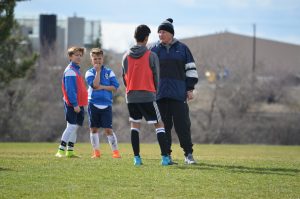
Playing a sport is one of the best things you can do for yourself as far as getting in shape and staying fit. Youth sports have been integral to promoting healthy, active lifestyles among kids.
Not only are youth sports beneficial for helping children stay in shape, they teach valuable lessons. Kids learn how to be good teammates. They develop a strong work ethic. And, hopefully, they realize the necessity of taking care of their bodies.
An injury can strike at any moment. Even the healthiest of athletes can get hurt. However, there are preventive measures you can take to minimize the risk.
Incorporate these safety tips into your life if you aren’t already. Start now; you’ll be doing yourself a huge favor in the long run.
Have a warm-up routine.
One of the best safety tips to follow is stretching before and after games and practices. There are tons of stretches you can do to loosen up.

Going for a slow jog gets your heart pumping and limbs moving without expending too much energy. Lifting light weights is another smart idea.
Giving your muscles a minor workout won’t stress them much before a game or practice. Doing this actually reduces the risk of ripping or tearing muscles.
Ultimately, what you do during your warm-up is up to you. Do what you find helpful. Your routine should change over time, so periodically evaluate what you do when you warm-up.
Stay hydrated.
You may be thinking “Duh!” when you see this tip, but it’s actually one of the most important safety tips out there. Drinking plenty of water is key to staying healthy.
Hydration greatly reduces the possibility of getting a heat-related illness. These illnesses can be serious and keep you out of a game.
Here are some common symptoms of dehydration:
- Dry mouth or tongue
- Extreme thirst
- Dizziness
- Fatigue
- Confusion
- Muscle cramps
In a day and age where there are all kinds of sports drinks, water still reigns supreme. Sports drinks may have the electrolytes athletes crave, but you can’t stay hydrated without water.
Ideally, teenage athletes should drink at least eight eight-ounce glasses of water per day. Younger athletes should strive to drink at least five.
Eat healthy.
Eating nutritious foods and sticking to a well-balanced diet is necessary to keep the body healthy and in tip-top shape. Foods like cut-up fruit, string cheese, and granola bars are all great snacks for young athletes.

Remember, the word “diet” doesn’t necessarily mean you are decreasing your caloric intake. Your diet is simply the kinds of food you eat. Athletes especially need to maintain a healthy level of calories to continue to perform well and stay in good shape.
It’s especially important to eat right on game day. You’re going to be expending a lot of energy while you play. Fueling up with the right foods will benefit your body tremendously before, during, and after the game.
Get a preseason physical.
You may feel great, but that doesn’t necessarily mean you’re physically ready to start the season. Maybe you have a nagging injury from the previous season or an ailment you weren’t even aware of.

You should be getting a physical every year anyway. Try to schedule your physical in the preseason, as close to the beginning of the season as possible.
The doctor can examine your heart for any possible heart conditions. They’ll also measure your blood pressure and check to see that your muscles and joints are healthy.
Don’t be stubborn and assume you’re in good health. Teams normally require a physical anyway. This safety tip is nonnegotiable. Be safe; get a preseason physical.
Make sure your gear fits properly.

Talk with the coach before the season begins so you know what equipment you’ll need, and give yourself enough time to get properly fitted gear.
Ill-fitting equipment raises the risk of injury. Sports gear is meant to protect athletes. Wearing incorrect sizes diminishes its value.
Cross-train or play multiple sports.
Youth sports have changed dramatically over the past decade. More kids are participating in one sport for most, if not the entire, year. This is known as specialization.
One of the downsides to specialization is overuse injuries. Because young athletes put stress on the same muscle groups throughout the year, they tend to encounter injuries such as stress fractures.
Even if young athletes follow safety tips, injuries due to overuse have a higher possibility of occurring than in athletes who take a break from their preferred sport.
There’s an analogy I often see that helps explain the risks of specialization and overusing muscles and joints: Imagine you have a credit card that you keep folding in half and unfolding. The longer you continue to fold and unfold the credit card, the weaker the plastic becomes. Until, eventually, it snaps.
When a 12-year-old kid is pitching year-round, their arm is going to suffer. You used to only hear about professional baseball pitchers getting Tommy John surgeries, but now even pitchers in youth leagues are having to undergo this procedure.
The risks of specialization don’t just apply to baseball players, mind you. Athletes from any sport are at a higher risk for overuse injuries if they specialize in one sport.
This is where cross-training and participating in multiple sports comes into play. Expanding your focus to work out a larger variety of muscles will yield desirable results.
Cross-training can also give you an edge on the field in terms of overall physicality. Playing multiple sports can satisfy a similar role. When an athlete is playing different sports over the course of a year, the muscles and joints being used vary greatly.
Sure, an injury can occur at any time, in any sport, but giving muscles a break is crucial to reducing the risk of injury. Check out this article from ESPN for more information on the benefits of being a multi-sport athlete.
Rest up.
Letting your body rest is one of the most vital safety tips on this list, and yet it often goes overlooked. You need to rest. Playing sports; especially the same sport; throughout the entire year can be harmful.

If these top athletes, who are in peak physical condition, recognize the importance of resting their bodies, players involved in youth sports should definitely do the same.
If you are someone who plays youth sports all year round, you might want to consider leaving a team. It’s a hard thing to do, but you need to think about your health and longevity.
Rest is a necessity for every athlete, from young kids in Little League to professional athletes. Otherwise, you are increasing the possibility of an injury or burning out mentally.
Share emergency info with the coach.

If you feel that you have any medical conditions that you want to specify to the coaching staff, do not hesitate to discuss it with them. These may include symptoms to watch out for, instructions for medications, and so on. Because it’s always best to err on the side of caution.
Research the coaching staff.
This tip can be useful for anyone but is especially helpful for those who are joining a new team. Playing for a coach who treats the team poorly is never fun. Researching how the coach and the staff run the team is an important thing to do before signing up.
There are a few ways you can do this: One, ask people who are already on the team. Parents and players are likely to give you accurate, honest feedback.
Two, check online. Many teams have Facebook pages or other social media accounts. These sites can help you get an idea of what the team atmosphere is like. Not just in terms of the coaching staff, but the players and parents as well.
Finding out how the coaching staff treats its players and how they run practices and games is important. But remember, it’s paramount to find out who on the staff is CPR and first-aid certified. Ideally, these people will be present at every practice and game.
There are guidelines put in place that require teams to have staff members who are certified in CPR and first aid. Finding out who and how many people on the staff are certified can give you some peace of mind.
Additionally, doing a background check on the coach is another worthwhile step you might want to consider taking.
Injuries can happen to anyone. Even the most careful athletes who follow safety tips such as these and take phenomenal care of themselves can get hurt. However, abiding by these safety tips will certainly reduce the likelihood of a young athlete getting injured.



